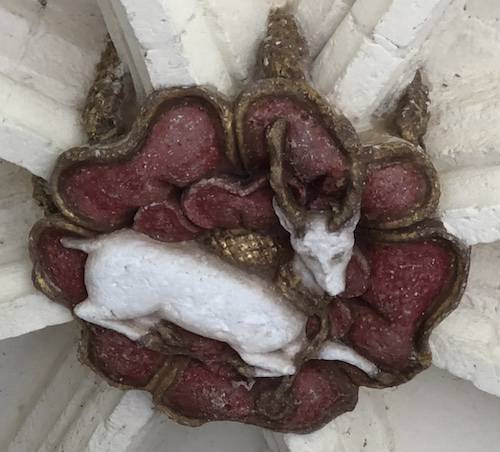
Dartington Hall and John Holand’s White Hart Badge
Dartington Hall and John Holand’s White Hart Badge
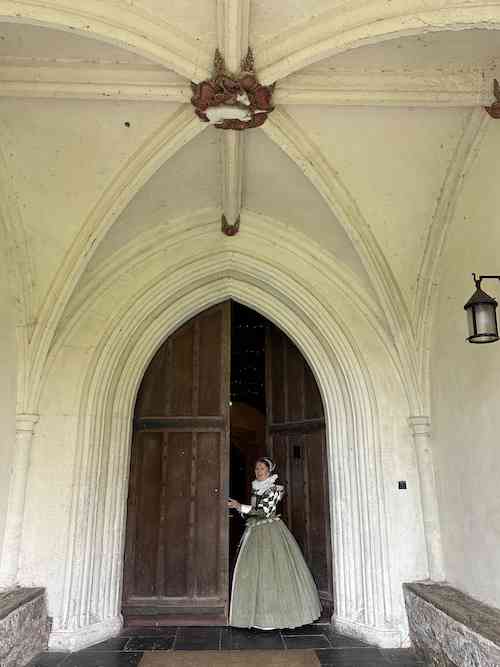
Always look up as you enter the porch at Dartington Hall. In the centre, where the ribs of the vaulting meet, you will see a carved boss; a white hart atop a red rose from beneath which a few wheat ears protrude.
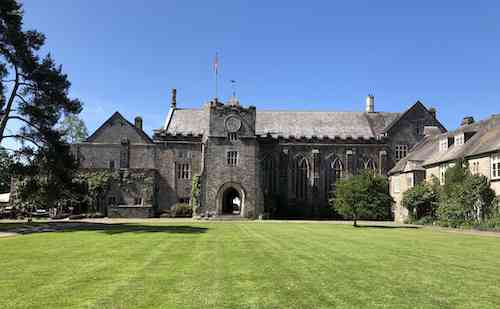
It is believed the carving was installed when John Holand (c.1352-16 January 1400), 1st Duke of Exeter, 1st Earl of Huntingdon and half brother of King Richard II, built the magnificent hall in the last years of the fourteenth century.
Badges, family crests, emblems and coats of arms — were all important heraldic symbols in medieval England. They could deliver very powerful messages understood by everyone without the need for words. In simplified but easily recognisable form they were embroidered onto standards for men to follow into battle or onto the tunics of the fighting men themselves. But what is the story of the badge carved on that roof boss at Dartington? John Holand placed it in a prominent position so that it would be seen by all who entered his hall. Exactly what message did it convey?
The White Hart
The white hart is easily identified as the emblem of John Holand’s half brother, Richard II. It was the badge worn by all the king’s retainers — even the angels are wearing it in the Wilton Diptych.
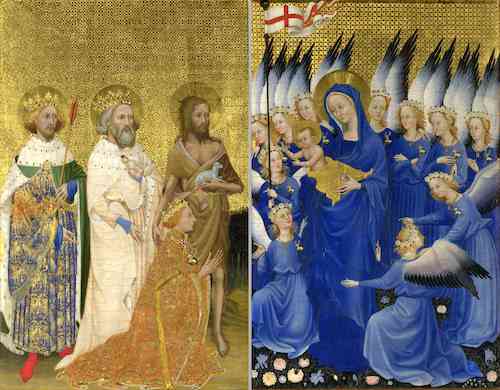
This striking image of the kneeling King clothed in a splendid cloak decorated liberally with white hart badges was created in the last five years of Richard’s life. It conveys a combination of religious and secular imagery which embodies Richard II’s personal conception of kingship.
.
King Edward III’s Queen, Philippa of Hainault, adopted the white hind as one of her badges. (The hind is the female deer and lacks antlers.) It is thought that Queen Philippa passed the badge on to her ward, Joan, known as “the Fair Maid of Kent," Countess of Kent and heiress of Edmund of Woodstock, Earl of Kent, the younger son of Edward I. Joan, the mother of both John Holand and King Richard II, added a gold crown about the hind’s neck and a gold pendant chain.
Richard II adopted his mother’s badge from the beginning of his reign in 1383, but changed the hind to a hart with antlers — the male deer — a beautiful mythical beast honoured in medieval times as special, as a creature set apart. The white hart symbol also acted as a visual pun on the King’s name (Richart in French). The hart with a chained coronet around its neck represented for the king a unique creature being captured in servitude to his kingdom. The hart’s portrayal of gentleness and its white colour might also suggest purity and Richard’s rejection of the warlike natures of his grandfather, Edward III and of his father, the Black Prince. Similar white hart symbols can be found in Westminster Hall.
John Holand’s loyalty to his half brother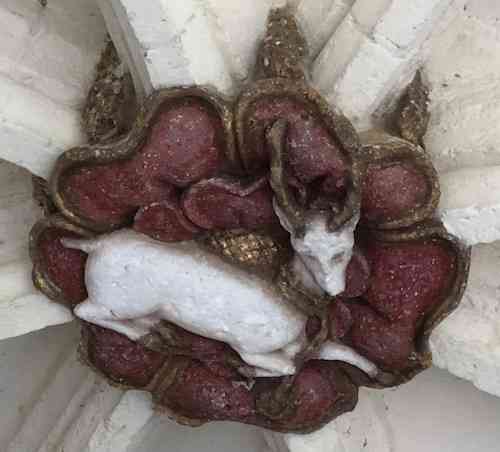
So the badge John Holand displayed in the porch at Dartington was clearly intended to show first and foremost his allegiance and loyalty to Richard.
The Dartington estate was first granted to Holand in 1584, but the grant was rescinded shortly afterwards when, in a fit of violent temper, he killed the Earl of Stafford who had approached him with an apology for the behaviour of one of his servants. Two years later Holand married Elizabeth of Lancaster, a daughter of John of Gaunt, Ist Duke of Lancaster (younger brother of the Black Prince). He and Elizabeth then joined Gaunt's expedition to Spain where Holand was appointed constable of the English army. After his return to England, on 2 June 1388, he was created Earl of Huntingdon and once again in possession of Dartington. In that year it was recorded that, “The buildings and site of the manor and park [at Dartington] are somewhat in decay though lack of repair.” The building work, including that badge, was completed sometime after that date.
John Holand continued to be rewarded for his service to King Richard. In 1389 he was appointed Lord Great Chamberlain for life, Admiral of the Fleet in the Western Seas and Constable of Tintagel Castle in Cornwall. He also received further large grants of land. In 1397 Holand was involved in the arrest of King Richard’s uncle, Thomas of Woodstock who had previously threatened his nephew with deposition and was implicated in a rebellion. As a reward, on 29 September 1397 Holand was created Duke of Exeter. Displaying the white hart badge on his newly built hall at that time signalled his continuing loyalty to his half brother.
In 1399 Things became difficult for Holand when his brother-in-law Henry of Bolingbroke, son of John of Gaunt, deposed Richard and took the throne as King Henry IV. Because of Holand’s involvement in the arrest and downfall of Thomas of Woodstock, the new king confiscated most of the lands Holand had received from King Richard and stripped him of his dukedom. While he initially seemed to transfer his allegiance to the new King, early in 1400 Holand was involved in a conspiracy against the new king, the Epiphany Rising. The plot failed and Holand fled, but was caught and executed on 16 January 1400.
The Rose and the wheat ears
The white hart badge in the Dartington porch sits on top of a cinquefoil rose — a stylised rose that is a common emblem in heraldry. Look to the sides of the porch are other rose emblems flanked by John Holand’s wheat ears. Those wheat ears are also underneath the central carving.
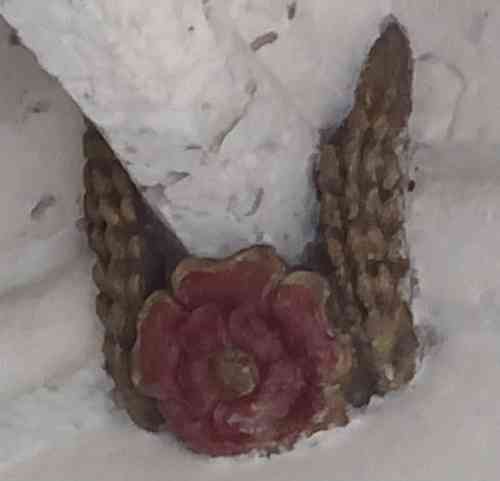
John Holand’s wheat ears therefore support the royal rose and the king’s white hart, just as he himself supported his brother.
Should the rose be red?
When the badge was restored in the nineteen twenties after Leonard and Dorothy Elmhirst came to Dartington, no traces of the original paint remained. The decision that the rose should be painted red may have been based on an assumed connection with the red rose of Lancaster, well known from the “Wars of the Roses”. It’s been argued that this may have been a mistake, since, the association of the Red Rose with the house of Lancaster may have come much later.
The wars between Lancaster and York that ravaged England throughout much of the fifteenth century were, at the time, called either “the civil” war or “the cousins’ war”. The association with two factions being represented by red and white roses occurs in a scene in Shakespeare’s Henry VI Part I in which Somerset (a Lancastrian) and York argue in the Temple garden, and they pick, respectively, a red rose and a white rose to represent their competing interests. The name “Wars of the Roses” was popularised in the nineteenth century by Sir Walter Scott.
By the late 1300s when Holand put up the badge the rose had long been a royal emblem. For example, Edward I adopted a golden rose as his badge in the thirteenth century. Its also thought that Edmund Crouchback, 1st Earl of Lancaster, chose the red flower for his emblem. There is some evidence that a red rose badge may have been adopted by John Holand’s father-in-law, John of Gaunt, the first Duke of Lancaster. For example, it has been recorded that Gaunt bequeathed to St Paul’s Cathedral his bed powdered with roses. It seems plausible that when he devised the Dartington badge John Holand was also referring to his support for his father-in-law whom it is said he had idolised in his youth.
The cinquefoil rose was adopted by Henry VII as the Tudor Rose which incorporates both red and white emblems, often assumed to represent the competing houses in what we now call the Wars of the Roses. However it has recently been suggested that the red rose, which does not seem to have emerged as a recognised Lancastrian symbol by 1585, might have been adopted by Margaret Beaufort, mother of Henry VII.
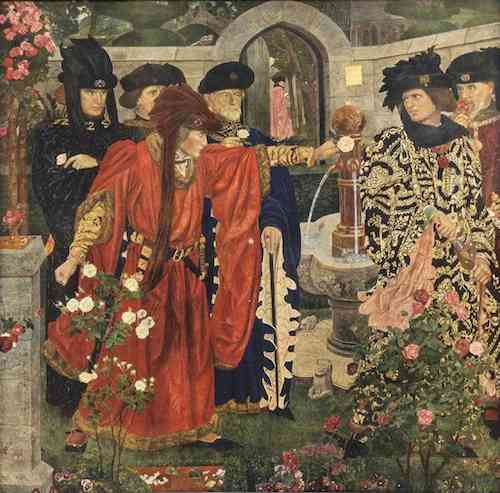
So its all a bit confused and as far as I’m concerned the jury is out. Whether that rose at Dartington should be red or another colour, I do believe the badge represents John Holand giving his full support to Plantagenet royalty, primarily his half-brother, King Richard II.
Rosemary Griggs
Sources include Dartington Hall by Anthony Emery
Images from Wikimedia Commons
The Wilton Diptych(The National Gallery)
"Plucking the Red and White Roses in the Old Temple Gardens" after the original 1910 fresco painting by Henry Albert Payne based upon a scene in Shakespeare's Henry VI, the original in the Palace of Westminster and a later similar painting by Payne in the Birmingham Museum and Art Gallery,
Other photos taken by author at Dartington Hall
If you’ve enjoyed this post please do share on social media using the buttons below.
